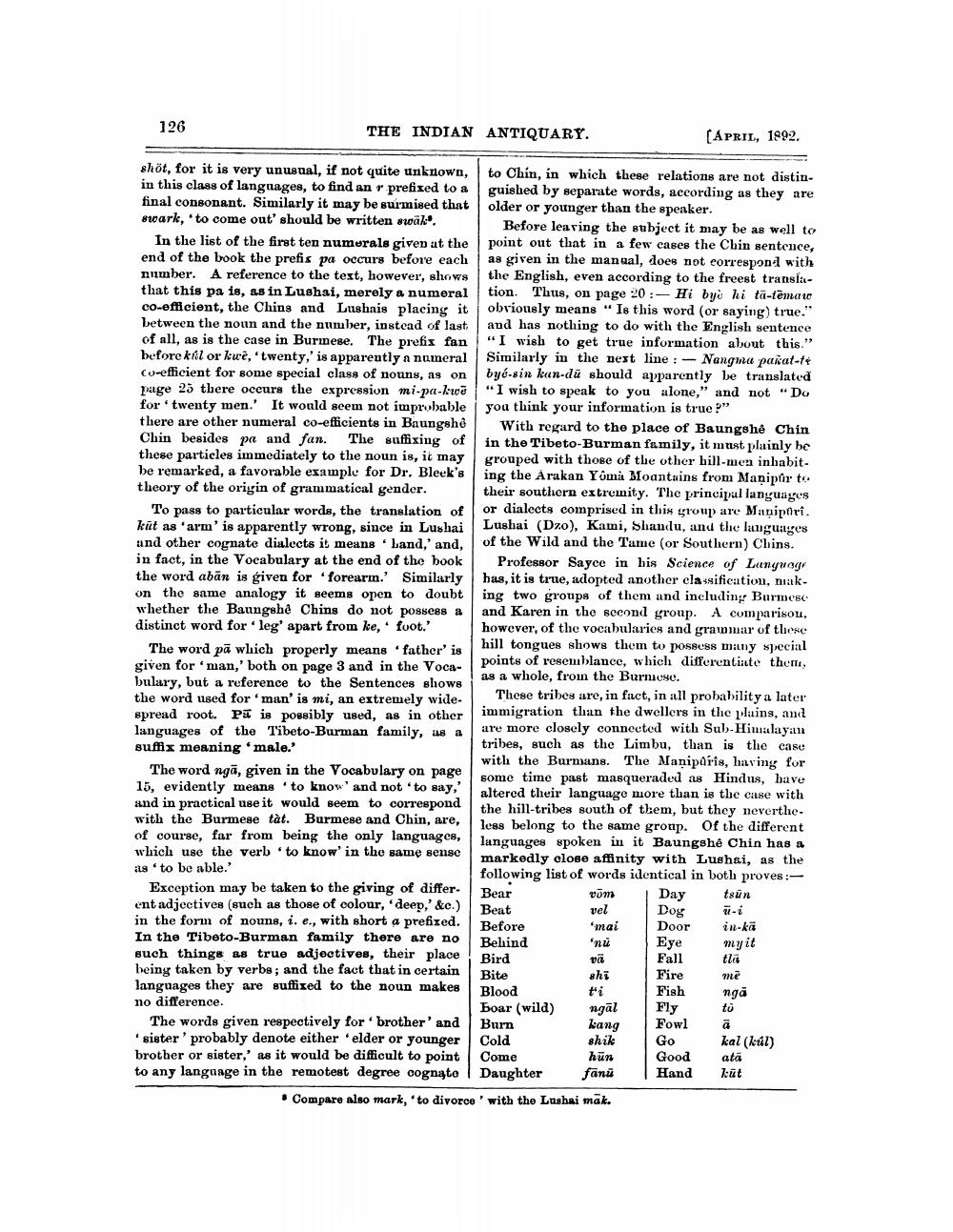________________
126
THE INDIAN ANTIQUARY.
(APRIL, 1992.
shöt, for it is very unusual, if not quite unknown, to Chin, in which these relations are not distinin this class of languages, to find an r prefixed to a guished by separate words, according as they are final consonant. Similarly it may be surmised that older or younger than the speaker. swark, to come out' should be written swak.
Before leaving the subject it may be as well to In the list of the first ten numerals given at the point out that in a few cases the Chin sentence, end of the book the prefis pa occurs before each as given in the manual, does not eorrespond with number. A reference to the text, however, shows the English, even according to the freest transitthat this pa is, as in Lushai, merely a numeral tion. Thus, on page 20 :- Hi byè hi ta-tēmai co-efficient, the China and Lushais placing its obviously means "Is this word (or saying) true." between the noun and the number, instead of last. and has nothing to do with the English sentenco of all, as is the case in Burmese. The prefis fan "I wish to get true information about this." before kål or kwê, 'twenty,' is apparently n numeral Similarly in the next line : - Nangma pakat-te Cu-efficient for some special class of nouns, as on byé-sin kan du should apparently be translated page 25 there occurs the expression mi-pa-kre "I wish to speak to you alone," and not "Do for twenty men.' It would seem not improbable you think your information is true?" there are other numeral co-efficients in Baungshe With regard to the place of Baungshé Chin Chin besides pa and fan. The suffixing of in the Tibeto-Burman family, it must plainly be these particles immediately to the noun is, it may grouped with those of the other hill-mea inhabit. be remarked, a favorable example for Dr. Bleek's ing the Arakan Yoma Boantuins from Manipur to theory of the origin of grammatical gender. their southern extremity. The principul languages
To pass to particular words, the translation of or dialects comprised in this group are Manipiri. küt as arm' is apparently wrong. since in Lushai | Lushai (Dzo), Kami, Shandu, and the languages and other cognate dialects it means Land,' and, of the Wild and the Tame (or Southern) Chins. in fact, in the Vocabulary at the end of the book Professor Sayce in his Science of Language the word abān is given for forearm. Similarly has, it is true, adopted another classification, niakon the same analogy it seems open to doubt ing two groups of them and including Burmese whether the Baungshê Chins do not possess a and Karen in the second group. A comparison, distinct word for ' leg' apart from ke, foot." however, of the vocabularies and grammar of these The word pā which properly means 'father is
hill tongues shows them to possess many special given for man,' both on page 3 and in the Voca
points of resemblance, which differentiate them, bulary, but a reference to the Sentences shows
as a whole, from the Burniese. the word used for 'man' is mi, an extremely wide
These tribes are, in fact, in all probability a later spread root. Pa is possibly used, as in other
immigration than the dwellers in the plains, and languages of the Tibeto-Burman family, is a
are more closely connected with Sul-Himalayan
tribes, such as the Limbu, than is the case sufix meaning 'male.'
with the Burmans. The Maniporis, having for The word ngā, given in the Vocabulary on page
some time past masqueraded is Hindus, bave 15, evidently means to know and not to say,
altered their language more than is the case with and in practical use it would seem to correspond
the hill-tribes south of them, but they neverthewith the Burmese tat. Burmese and Chin, are,
less belong to the same group. Of the different of course, far from being the only languages,
languages spoken in it Baungshê Chin has a which use the verb to know' in the same senso
markedly close affinity with Lushai, as the as to be able.'
following list of words identical in both proves :Exception may be taken to the giving of differ.
Bear
vom Day tsun ont adjectives (such as those of colour, deep,' &e.)
Beat
vel Dog in the form of nouns, i. e., with short a prefized.
Before
'mai Door in-kā In the Tibeto-Burman family there are no
Behind
'nü Eye myit such things as true adjectives, their place
Bird
Fall tlat being taken by verbs; and the fact that in certain
Bite
shi Fire me languages they are suffixed to the noun makes
Blood
Fish nga no difference.
boar (wild) ngal Fly The words given respectively for brother' and
Burn
Fowl sister' probably denote either elder or younger Cold
shik Go kal (kúl) brother or sister,' as it would be difficult to point
hün Good ata to any language in the remotest degree cognato | Daughter fānu Hand kūt
• Compare also mark, 'to divorce' with the Lashai mak.
та
kang




